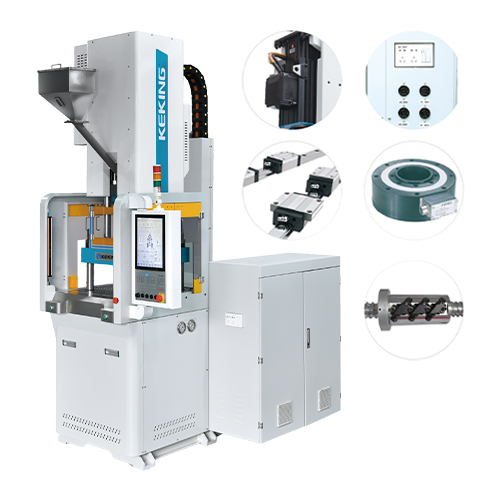The clamping system of a vertical injection molding machine plays a crucial role in the injection molding process. It ensures that the mold can be tightly closed, withstand injection pressure, and guarantee the quality of product molding. However, during long-term operation, various faults may occur in the mold closing system, such as loose mold closing and slow mold opening and closing actions, which seriously affect production efficiency. Mastering scientific methods for troubleshooting and resolving faults is the key to ensuring the normal operation of equipment.
Loose mold closing is one of the common faults. The reasons may involve multiple aspects. First of all, check whether the pressure of the hydraulic system is insufficient. The hydraulic system provides power for the mold closing action. If the system pressure fails to reach the set value, the mold cannot close tightly. Use a pressure gauge to detect the pressure of the hydraulic system. If the pressure is low, it is necessary to check whether the hydraulic pump is worn. Wear of the internal parts of the pump will lead to a decrease in volumetric efficiency, insufficient output flow and pressure. At the same time, check whether the relief valve is faulty. If the relief valve is stuck in the normally open position, it will cause a large amount of hydraulic oil to flow back, resulting in the system pressure being unable to rise. For worn hydraulic pumps, repair or replacement is required. If the relief valve malfunctions, it should be disassembled and cleaned to check if there are any scratches or impurities blocking the valve core. If necessary, a new relief valve should be replaced.

Secondly, mechanical component issues of the mold closing mechanism may also lead to loose mold closing. Check whether the pull rod is deformed or worn. During the mold closing process, the pull rod bears a huge tensile force. If it deforms, the mold will not be evenly stressed, resulting in a loose mold closing. Observe whether there are obvious scratches or dents on the surface of the pull rod, and measure whether its diameter is within the standard range. If it does not meet the requirements, the pull rod needs to be replaced. In addition, if the sealing parts of the mold closing cylinder age or get damaged, it will cause hydraulic oil leakage, resulting in insufficient thrust of the cylinder and thus affecting the mold closing effect. The oil cylinder needs to be disassembled to check the condition of the sealing parts and replace the aged or damaged sealing parts in time.
Slow opening and closing of the mold is also a common fault in the mold closing system. Insufficient flow in the hydraulic system is one of the important reasons. Check whether the oil level in the oil tank is too low. If the oil level is too low, it will cause the hydraulic pump to have insufficient oil suction and a decrease in output flow. If the oil level is too low, the same type of hydraulic oil should be replenished to the standard oil level. At the same time, check whether the hydraulic oil filter is clogged. A clogged filter will increase the flow resistance of the oil and reduce the flow rate. If the filter is severely clogged, the filter element should be replaced in time. In addition, if the valve core of the directional control valve is stuck or worn, it will affect the flow direction and volume of the hydraulic oil, resulting in slow opening and closing of the mold. The directional control valve needs to be cleaned and inspected, and the valve core should be replaced if necessary.
In terms of mechanical transmission, if the guide rails and sliders of the mold closing mechanism are poorly lubricated, it will increase the frictional resistance, causing the mold opening and closing actions to be slow. Check the lubrication of the guide rails and sliders. If the lubricating oil is dry or insufficient, replenish the grease in time and clean the impurities on the surface of the guide rails and sliders to ensure good lubrication. In addition, if the transmission chain or belt of the mold closing mechanism is loose, it will lead to a decrease in power transmission efficiency and result in slow mold opening and closing actions. The tension of the chain or belt needs to be adjusted to reach an appropriate state.
Faults in the electrical control system may also affect the normal operation of the mold closing system. Check whether the relays and contactors that control the mold closing action are damaged. If the contacts are burned or the coils are faulty, it will cause the control signals to fail to be transmitted normally, affecting the mold closing action. Use a multimeter to test the electrical parameters of relays and contactors. If faults are found, components of the same specification need to be replaced. At the same time, check whether the limit switch is working properly. The limit switch is used to control the travel and position of the mold closing mechanism. If it is damaged or installed in an improper position, it will cause abnormal mold closing actions. The position of the limit switch needs to be adjusted or a new limit switch replaced to ensure that the mold closing system can operate accurately.





